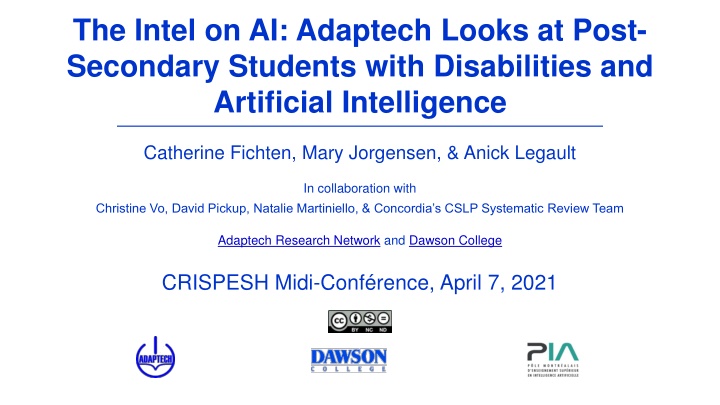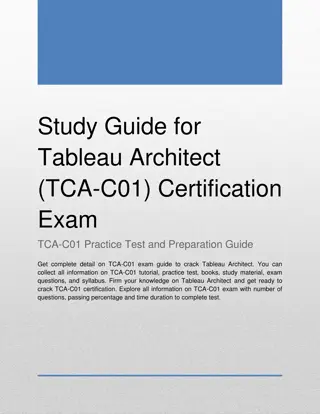
Adaptech Research on AI for Post-Secondary Students with Disabilities
Discover the potential of AI technologies for post-secondary students with disabilities through a systematic review by Adaptech. Explore findings on technology use during Covid-19, virtual intelligent assistants, and implications for student support. Uncover insights from studies on schoolwork methods, results, and conclusions for students with and without disabilities.
Download Presentation

Please find below an Image/Link to download the presentation.
The content on the website is provided AS IS for your information and personal use only. It may not be sold, licensed, or shared on other websites without obtaining consent from the author. If you encounter any issues during the download, it is possible that the publisher has removed the file from their server.
You are allowed to download the files provided on this website for personal or commercial use, subject to the condition that they are used lawfully. All files are the property of their respective owners.
The content on the website is provided AS IS for your information and personal use only. It may not be sold, licensed, or shared on other websites without obtaining consent from the author.
E N D
Presentation Transcript
The Intel on AI: Adaptech Looks at Post- Secondary Students with Disabilities and Artificial Intelligence Catherine Fichten, Mary Jorgensen, & Anick Legault In collaboration with Christine Vo, David Pickup, Natalie Martiniello, & Concordia s CSLP Systematic Review Team Adaptech Research Network and Dawson College CRISPESH Midi-Conf rence, April 7, 2021
Presentation Objectives What is the potential of AI-based technologies for post- secondary students with disabilities? Findings from 4 studies 2 studies of students with and without disabilities What AI-based technologies are used during the Covid-19 pandemic How do students use virtual intelligent assistants for schoolwork 1 Systematic review 1 Advisory board meeting Implications 2
Study 1. Covid-19 Pandemic - Method Goal What technologies are used to do schoolwork Method 163 students with disabilities 74 students without disabilities LimeSurvey 3
Study 1. Covid-19 Pandemic - Results Zoom can include captions ( craptions ) Google Docs speech-to-text, collaboration Microsoft Word speech-to-text, grammar, spell check Calendars reminders, alerts Microsoft Teams transcription (with Stream) Office suites (Google, Microsoft) To do lists and notes (can work across platforms) 4
Study 1. Covid-19 Pandemic - Conclusions Most worked well For both groups of students But Zoom had problems for over 1/3 of students Microsoft Teams: problems for 50% students with disabilities When problems, more for students with disabilities 5
Study 2. Virtual Intelligent Assistants - Method Goal How did students use virtual assistants on mobile devices Method 121 students with disabilities 51 students without disabilities LimeSurvey 6
Study 2. Virtual Intelligent Assistants Results 1 Overall, little use made of these Similar proportions of the 2 groups More smartphones than tablets More Apple than Android Virtual assistant Students with a disability Google Assistant Siri Alexa Bixby Students without disabilities 8% 12% 4% 2% 15% 12% 2% 2% 7
Study 2. Virtual Intelligent Assistants Results 2 Mainly Scheduling /calendars /alerts, internet /research, dictionary Google Assistant Alexa Bixby Total 8 3 9 2 2 1 2 2 2 1 1 Activity Siri 9 2 6 4 1 1 2 21 13 10 7 3 3 2 2 Schedule/calendar/alerts/reminders Internet/research Dictionary/definitions Spelling Timer Read books Calculate Translate 1 2 8
Study 2. Virtual Intelligent Assistants Results 3 Input modality Google Assistant mainly talking Siri half talking half typing Alexa Amazon Echo (talking) Bixby not specified Overall, potential of virtual assistants not realized 9
Study 3. Google Search and AI Pole The excitement about AI advances Digitally intelligent TA: Jill Watson Wearable AI devices for students with disabilities Virtual intelligent assistant for students services, library, etc. Alexa, Google Assistant, Siri 10
Study 3. Systematic Review Total = 41 Empirical = 20; relevant 6 Conceptual = 21; relevant 13 Empirical studies Methods are varied Most are quantitative Disability groups studied Hearing and visual impairments, ASD, chronic health, etc. 11
Study 3. Implications Lack of general agreement on AI definition Discrepancies between the hype and data Weak vs. Strong AI Reality vs. the promise of AI If Strong AI doesn t exist, let s focus on weak AI 12
Study 4. Advisory Board Meetings Method 1 2 meetings via Zoom Total number of participants (n = 38) Diverse stakeholders 7 students with and without disabilities 3 disability / accessibility service providers 14 faculty members 9 technology experts 5 technology users with disabilities Martiniello, N., Asuncion, J., Fichten, C., Jorgensen, M., Havel, A., Harvison, M., Legault, A., Lussier, A., & Vo, C. (2021). Artificial intelligence for students in postsecondary education: A world of opportunity. AI Matters, 6(3), 17-29. https://doi.org/10.1145/3446243.3446250 13
Study 4. Advisory Board Meetings Method 2 Questions AI-based technologies Currently used by postsecondary students with disabilities Rarely considered but could help students with disabilities Could help in the future 14
Study 4. Advisory Board Meetings Results 1 AI tools used by postsecondary students Chatbots AI-enabled text-based conversationalists Possible uses Answer students questions Content in learning management systems Service hours (e.g., library, counselling) Schedule 15
Study 4. Advisory Board Meetings Results 2 AI tools used by postsecondary students cont d Emotional, mental health, and medical regulation AI-informed app-based tools providing point-in-time support Brain in Hand Empower Me SeizAlarm, My Medic Watch, and Smart-Watch Inspyre Woebot 16
Study 4. Advisory Board Meetings Results 3 AI tools used by postsecondary students cont d Tools Increase the speed, improve the efficiency of entering text SwiftKey and FlickType UNI Word prediction 17
Study 4. Advisory Board Meetings Results 4 AI tools used by postsecondary students cont d Accessing visual/textual information in alternative format Seeing AI and Office Lens SMMRY or Reddit s AutoTLDR bot OrCam CamFind 18
Study 4. Advisory Board Meetings Results 5 AI tools used by postsecondary students cont d Accessing information in diverse formats Captions Built-in dictation feature Just Press Record Voiceitt 19
Study 4. Advisory Board Meetings Implications Improve functionality of existing technologies Privacy and security concerns Include students with disabilities in training data Make information about AI-based technologies available Accessible training documents (e.g., YouTube, Google) Students with disabilities are a valuable stakeholders in AI development 20
Thank You! Questions? Listing of all AI-based technologies: https://adaptech.org/research/how -can-virtual-assistants-and-ai- based-smartphone-apps-help-post- secondary-students-with- disabilities-succeed-in-their-studies Adaptech Research Network: www.adaptech.org Catherine Fichten: catherine.fichten@mcgill.ca Mary Jorgensen: mjorgensen@dawsoncollege.qc.ca 21






